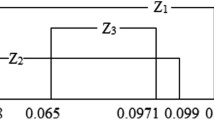Abstract
A general optimization problem whose parameters and decision variables are intervals, is known as an enhanced interval optimization problem. This article has focused on nonlinear enhanced interval optimization problem. Here, a methodology is derived to determine the efficient solutions of this problem. Theoretical justification for the existence of the solution to this problem is discussed. In this process, the original problem is transformed into a deterministic form, which is free from interval uncertainty. Relation between the solution of the original problem and the corresponding deterministic problem is established. Furthermore, numerical examples are provided to support the theoretical development.




Similar content being viewed by others
References
Allahdadi M, Nehi HM (2013) The optimal solution set of the interval linear programming problems. Optim Lett 7(8):1893–1911
Bhurjee AK, Padhan SK (2016) Optimality conditions and duality results for non-differentiable interval optimization problems. J Appl Math Comput 50(1):59–71
Bhurjee AK, Panda G (2012) Efficient solution of interval optimization problem. Math Methods Oper Res 76(3):273–288
Bhurjee AK, Panda G (2016) Sufficient optimality conditions and duality theory for interval optimization problem. Ann Oper Res 243(1):335–348
Chalco-Cano Y, Lodwick W, Rufian-Lizana A (2013) Optimality conditions of type KKT for optimization problem with interval-valued objective function via generalized derivative. Fuzzy Optim Decis Mak 12(3):305–322
Chinneck JW, Ramadan K (2000) Linear programming with interval coefficients. J Oper Res Soc 51(2):209–220
Ghosh D, Ghosh D, Bhuiya SK, Patra LK (2018) A saddle point characterization of efficient solutions for interval optimization problems. J Appl Math Comput 58(1):193–217
Guo P, Huang G, Zhu H, Wang X (2010) A two-stage programming approach for water resources management under randomness and fuzziness. Environ Model Softw 25(12):1573–1581
Hansen E, Walster G (2004) Global optimization using interval analysis second edition, revised and expanded. Pure and Applied Mathematics-Marcel Dekker Incorporated 264
Hladik M (2009) Optimal value range in interval linear programming. Fuzzy Optim Decis Mak 8(3):283–294
Hladik M (2011) Optimal value bounds in nonlinear programming with interval data. TOP 19(1):93–106
Hu B, Wang S (2006) A novel approch in uncertain programming: part i: new arithemetic and order relation ofr interval numbers. J Ind Manag Optim 2(4):351–371
Ishibuchi H, Tanaka H (1990) Multiobjective programming in optimization of the interval objective function. Eur J Oper Res 48(2):219–225
Jana M, Panda G (2014) Solution of nonlinear interval vector optimization problem. Oper Res 14(1):71–85
Jana M, Panda G (2015) Multi-objective geometric programming with varying parameters: application in waste water treatment system. Math Model Anal 20(5):585–603
Jiang C, Han X, Liu G, Liu G (2008) A nonlinear interval number programming method for uncertain optimization problems. Eur J Oper Res 188(1):1–13
Jiang C, Zhang Z, Zhang Q, Han X, Xie H, Liu J (2014) A new nonlinear interval programming method for uncertain problems with dependent interval variables. Eur J Oper Res 238(1):245–253
Kumar P, Panda G (2017) Solving nonlinear interval optimization problem using stochastic programming technique. OPSEARCH 54(4):752–765
Kumar P, Panda G, Gupta U (2013) Generalized quadratic programming problem with interval uncertainty. In: IEEE international conference on fuzzy systems (FUZZ), IEEE, pp 1–7
Kumar P, Panda G, Gupta UC (2015) Portfolio rebalancing model with transaction costs using interval optimization. OPSEARCH 52(4):827–860
Kumar P, Panda G, Gupta UC (2016) An interval linear programming approach for portfolio selection model. Int J Oper Res 27(1/2):149–164
Kumar P, Panda G, Gupta U (2018) Multiobjective efficient portfolio selection with bounded parameters. Arab J Sci Eng 43(6):3311–3325
Li D, Leung Y, Wu W (2019) Multiobjective interval linear programming in admissible-order vector space. Inf Sci 486:1–19
Li W, Tian X (2008) Numerical solution method for general interval quadratic programming. Appl Math Comput 202(2):589–595
Liu ST, Wang RT (2007) A numerical solution method to interval quadratic programming. Appl Math Comput 189(2):1274–1281
Markowitz H (1952) Portfolio selection. J Finance 7:77–91
Moore RE (1966) Interval analysis, vol 4. Prentice-Hall Englewood Cliffs, Upper saddle River
Rohn J (1994) Positive definiteness and stability of interval matrices. SIAM J Matrix Anal Appl 15:175–184
Tong S (1994) Interval number and fuzzy number linear programmings. Fuzzy Sets Syst 66(3):301–306
Wang S, Huang G (2011) Interactive two-stage stochastic fuzzy programming for water resources management. J Environ Manag 92(8):1986–1995
Wang S, Huang G (2012) Identifying optimal water resources allocation strategies through an interactive multi-stage stochastic fuzzy programming approach. Water Resour Manag 26(7):2015–2038
Wu HC (2008) On interval-valued nonlinear programming problems. J Math Anal Appl 338(1):299–316
Wu HC (2009) The Karush-Kuhn-Tucker optimality conditions in multiobjective programming problems with interval-valued objective functions. Eur J Oper Res 196(1):49–60
Yan XS (2008) Liquidity, investment style, and the relation between fund size and fund performance. J Financ Quant Anal 43(3):741–767
Zhou F, Huang GH, Chen GX, Guo HC (2009) Enhanced-interval linear programming. Eur J Oper Res 199(2):323–333
Acknowledgements
The authors would like to thanks Professor Geetanjali Panda for her expert advice, assistance, and encouragement; the referees for their comments and suggestions that led the paper into the current form, as well as the Center for Theoretical Studies, Indian Institute of Technology Kharagpur for support.
Author information
Authors and Affiliations
Corresponding author
Ethics declarations
Conflict of interest
The authors declare that they have no conflict of interest
Ethical approval
This article does not contain any studies with human participants or animals performed by any of the authors.
Additional information
Publisher's Note
Springer Nature remains neutral with regard to jurisdictional claims in published maps and institutional affiliations.
Rights and permissions
About this article
Cite this article
Kumar, P., Bhurjee, A.K. An efficient solution of nonlinear enhanced interval optimization problems and its application to portfolio optimization. Soft Comput 25, 5423–5436 (2021). https://doi.org/10.1007/s00500-020-05541-z
Published:
Issue Date:
DOI: https://doi.org/10.1007/s00500-020-05541-z




